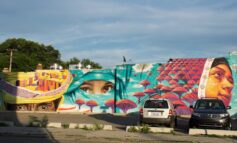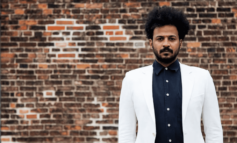
BEIRUT (IPS) — Can beauty arise from conflict? When looking at the art scene in the Middle East, where a fault line of political instability stretches from Lebanon, Syria and Israel to Iraq and Iran, the answer seems to be a resounding ‘yes.’
Artists living in war zones tend to express the harsh realities of battle, depicting violence, anxiety, fear and death in a myriad of images, statues, still objects and symbols, making splendor out of agony. Paintings from the 1980-1988 Iran-Iraq war for example show the concept of Shi’a martyrdom, with religious, political and social struggles captured with each stroke of the brush.
“I tend to integrate aggression in some of my pieces, because it triggers tension. This clash in my paintings stems from my country’s environment, where ugliness and beauty constantly collide,” says Iranian artist Reza Derakshani. He adds that the strict dress code imposed on Iranian women also inspires his creativity.
Derakshani’s ‘Rose and Nightingale’ exhibition, held in Dubai early this year, re-interpreted an ancient Persian theme in a contemporary way — using Plexiglas, vibrant reds and dark hues as well as transparent whites combined with crystal turquoises. It elicited a powerful mix of feelings in the public. “(My work) sparks off emotions of sadness and happiness at the same time, which is inherently reflective of my culture,” he explains.
Lebanese artist Hassan Jouni, who started painting in 1963, witnessed first hand his country’s 1975-1990 civil war, which left his homeland in tatters, with hundreds of thousands dead, missing or injured. “I felt war coming and reproduced this feeling in my creations,” says Jouni. “We live in a region where political tensions constantly run high.”
His works, which seem buried in darkness or suddenly yielding to light color, have translated on canvas some of Lebanon’s darkest moments of history. “I was a spectator to the war in my country, which I saw slowly fracturing away and dissolving, and I had to express it somehow.”
The artist says his pieces could only reflect the havoc wreaked by the conflict because the war was a deeply personal and unique experience. “I witnessed my friends dying in the streets. I have always been appalled by the injustice and blindness of war.” In one of his paintings, a handsome horse is attacked by birds, illustrating the destruction of the nation; in another, a group of despondent refugees sits on the ground, signifying despair.
War in the region has not only influenced pieces of art, but has modified the structure of the art scene. Iranian, Iraqi and Lebanese artists have left their home countries in search of more serene skies, where they are able to create their art in peace.
Mohamad el-Attar, owner of a small gallery located at the southern end of Jabal Amman, one of the Jordanian capital’s oldest quarters, believes that the exodus of Iraqi artists to the Hashemite kingdom since the beginning of sanctions against Iraq, and the war, contributed to a revival of the local art scene. “Iraqi artists brought color, refinement and creativity,” he says.
Arab artists from beleaguered countries seem to be circling the globe and establishing ateliers in the West, settling in cities like London and New York. They are supported by rich patrons, who often belong to their own diaspora.
“Scores of Lebanese artists are fleeing to countries where their creations can truly be appreciated. Here, they often have to take a second job to make ends meet and are considered third, if not fourth class citizens,” says Odile Mazloum from the Alwan Gallery in Lebanon. As a result of the country’s prevailing instability, galleries have also been closing down one after another, says Mazloum.
Although war has certainly been depleting the pool of artistic talent, it has also undoubtedly further fuelled imagination and fervor. “Creation stems from destruction,” says Derakshani, “that is the rule of life and it is the same with art.”





Leave a Reply